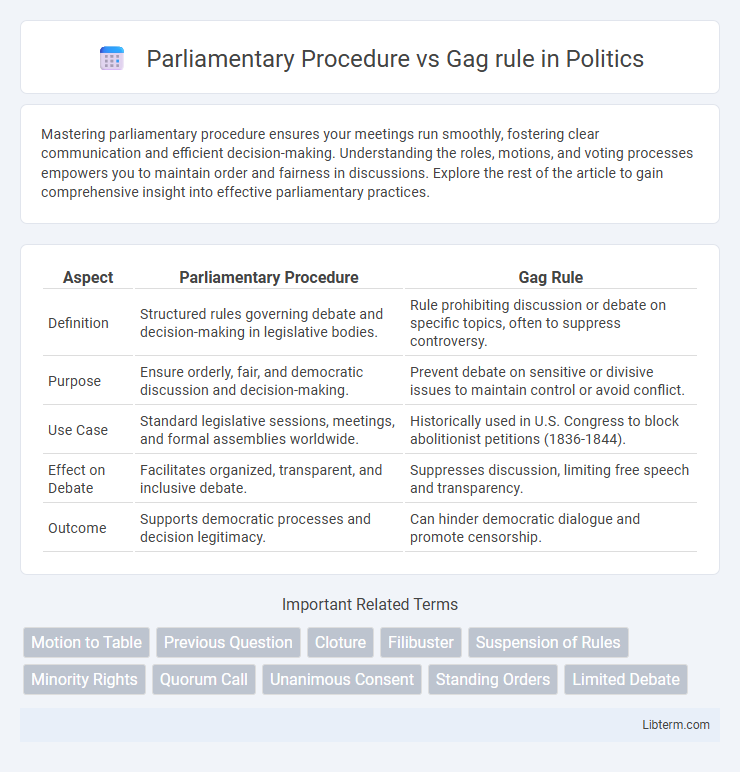Mastering parliamentary procedure ensures your meetings run smoothly, fostering clear communication and efficient decision-making. Understanding the roles, motions, and voting processes empowers you to maintain order and fairness in discussions. Explore the rest of the article to gain comprehensive insight into effective parliamentary practices.
Table of Comparison
| Aspect | Parliamentary Procedure | Gag Rule |
|---|---|---|
| Definition | Structured rules governing debate and decision-making in legislative bodies. | Rule prohibiting discussion or debate on specific topics, often to suppress controversy. |
| Purpose | Ensure orderly, fair, and democratic discussion and decision-making. | Prevent debate on sensitive or divisive issues to maintain control or avoid conflict. |
| Use Case | Standard legislative sessions, meetings, and formal assemblies worldwide. | Historically used in U.S. Congress to block abolitionist petitions (1836-1844). |
| Effect on Debate | Facilitates organized, transparent, and inclusive debate. | Suppresses discussion, limiting free speech and transparency. |
| Outcome | Supports democratic processes and decision legitimacy. | Can hinder democratic dialogue and promote censorship. |
Introduction to Parliamentary Procedure
Parliamentary procedure is a systematic set of rules used to conduct meetings and make decisions efficiently within legislative bodies and organizations. It ensures orderly discussion, fair participation, and clear decision-making by following established guidelines such as Robert's Rules of Order. In contrast, a gag rule restricts debate or discussion on certain topics, limiting members' ability to fully engage in parliamentary processes.
Defining the Gag Rule
The gag rule is a procedural measure in legislative bodies that prohibits the discussion or consideration of specific topics, effectively silencing debate and delaying decision-making. Unlike parliamentary procedure, which provides a structured framework for orderly debate and decision-making, the gag rule restricts members' ability to address certain issues, often to suppress controversial or sensitive subjects. This mechanism is frequently used to control legislative agendas and limit democratic discourse within parliamentary settings.
Historical Background of Parliamentary Procedure
Parliamentary procedure originated in the English Parliament during the 13th century, evolving to establish orderly and democratic debate through formal rules and customs. Rooted in Sir Thomas Erskine May's 19th-century treatise "Parliamentary Practice," these procedures standardized legislative processes and ensured majority rule with respect to minority rights. Unlike the gag rule, which restricts discussion on specific issues, parliamentary procedure promotes transparency and fairness in legislative deliberations.
Origins and Uses of the Gag Rule
The Gag Rule originated in the early 19th century as a parliamentary procedure used primarily in the U.S. House of Representatives to automatically table anti-slavery petitions, effectively preventing debate on the contentious issue. Its use was instrumental from 1836 to 1844 in circumventing discussions about slavery, reflecting the intense sectional conflicts of the era. The rule exemplified a method of limiting legislative deliberation on specific topics, contrasting with broader parliamentary procedures designed to manage debate and maintain order.
Key Principles of Parliamentary Procedure
Parliamentary procedure is governed by key principles such as fairness, justice, equal participation, and majority rule, ensuring orderly and democratic decision-making during meetings. It emphasizes the right of members to express opinions, propose motions, and debate issues while maintaining decorum and efficient conduct. Unlike the gag rule, parliamentary procedure protects free discussion and transparency, preventing arbitrary suppression of debate.
Purpose and Implementation of Gag Rules
Gag rules serve to limit or prohibit discussion on specific topics within legislative bodies, primarily to maintain order and avoid contentious debates, often restraining freedom of speech on particular issues. Implemented through formal motions or resolutions, gag rules restrict members from introducing or debating certain subjects, effectively controlling parliamentary discourse and legislative agenda. These rules contrast with general parliamentary procedures, which provide structured guidelines for debate and decision-making without inherently suppressing speech.
Impact on Legislative Debate and Deliberation
Parliamentary procedure ensures structured and fair legislative debate by establishing clear rules for discussion, motion handling, and decision-making, promoting transparency and equal participation among members. The gag rule, by contrast, restricts or prohibits discussion on specific topics, effectively limiting freedom of speech and suppressing dissenting opinions, which undermines thorough deliberation and legislative scrutiny. These differences critically impact the quality and openness of legislative processes, shaping policy outcomes and democratic accountability.
Democratic Values: Open Debate vs. Suppression
Parliamentary procedure ensures democratic values by promoting open debate and transparent decision-making, allowing diverse viewpoints to be expressed and considered. In contrast, a gag rule suppresses discussion by restricting or prohibiting debate on certain topics, undermining the principles of free speech and democratic participation. This tension highlights the fundamental conflict between fostering inclusive governance and enforcing control over legislative discourse.
Case Studies: Parliamentary Procedure vs. Gag Rule in Action
Case studies illustrate the distinct applications of parliamentary procedure and gag rule in legislative bodies, highlighting their impacts on debate and decision-making. In the U.S. House of Representatives during the 1830s, gag rules effectively suppressed anti-slavery petitions, demonstrating how gag rules can limit discourse to maintain control. Conversely, the 1919 Senate debate on the Treaty of Versailles showcased parliamentary procedure facilitating structured discussion and amendments, allowing comprehensive analysis before voting.
Conclusion: Balancing Order and Free Expression
Parliamentary procedure establishes structured rules to maintain order and ensure fair debate, while the Gag rule limits discussion on specific topics, potentially restricting free expression. Effective governance requires balancing these mechanisms to uphold orderly deliberation without suppressing diverse viewpoints. Striking this balance fosters democratic decision-making and protects the principles of open dialogue and transparency.
Parliamentary Procedure Infographic

 libterm.com
libterm.com